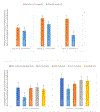Coital Frequency and Male Concurrent Partnerships During Pregnancy and Postpartum in Agbogbloshie, Ghana
- PMID: 30673896
- PMCID: PMC6536330
- DOI: 10.1007/s10461-019-02403-0
Coital Frequency and Male Concurrent Partnerships During Pregnancy and Postpartum in Agbogbloshie, Ghana
Abstract
During pregnancy and postpartum, women in high HIV prevalence regions continue to be at high risk for acquiring HIV, due to both behavioral and biological mechanisms, despite declines in coital frequency as a pregnancy advances. We estimated differences in rates of partnership concurrency for men with and without pregnant or postpartum sexual partners. We used monthly retrospective panel data from Ghana from three perspectives: couple-level data, female reports of pregnancy and male partner concurrency, and male reports of concurrent partnerships and female partner pregnancy. Coital frequency increased during the first trimester and then declined with advancing pregnancy. However, in all three analyses, there was no compelling evidence that men with pregnant or postpartum partners had additional concurrent partnerships. Our findings suggest that even though women's sexual activity likely declines during pregnancy and postpartum, they may not be at increased risk of HIV/STI due to their partners seeking additional partnerships.
Keywords: Agbogbloshie; HIV/STI; Multiple concurrent partnerships; Postpartum; Pregnant.
Conflict of interest statement
Drs. Cassels, Jenness, and Biney declare that we have no conflict of interest. The Institutional Review Boards of the University of Washington and the Noguchi Memorial Institute for Medical Research, University of Ghana, approved the study protocols. Informed consent was obtained from all individual participants included in the study.
Figures


Similar articles
-
Is It the Timing? Short-Term Mobility and Coital Frequency in Agbogbloshie, Ghana.Arch Sex Behav. 2021 Feb;50(2):589-600. doi: 10.1007/s10508-020-01815-7. Epub 2020 Sep 28. Arch Sex Behav. 2021. PMID: 32989638 Free PMC article.
-
Characteristics of multiple and concurrent partnerships among women at high risk for HIV infection.J Acquir Immune Defic Syndr. 2014 Jan 1;65(1):99-106. doi: 10.1097/QAI.0b013e3182a9c22a. J Acquir Immune Defic Syndr. 2014. PMID: 24056163 Free PMC article.
-
Timing is everything: international variations in historical sexual partnership concurrency and HIV prevalence.PLoS One. 2010 Nov 24;5(11):e14092. doi: 10.1371/journal.pone.0014092. PLoS One. 2010. PMID: 21124829 Free PMC article.
-
Geographic mobility and potential bridging for sexually transmitted infections in Agbogbloshie, Ghana.Soc Sci Med. 2017 Jul;184:27-39. doi: 10.1016/j.socscimed.2017.05.003. Epub 2017 May 5. Soc Sci Med. 2017. PMID: 28501018 Free PMC article.
-
Love, lust and the emotional context of multiple and concurrent sexual partnerships among young Swazi adults.Afr J AIDS Res. 2014;13(2):133-43. doi: 10.2989/16085906.2014.927781. Afr J AIDS Res. 2014. PMID: 25174630 Free PMC article.
Cited by
-
Screening for Resistant Bacteria, Antimicrobial Resistance Genes, Sexually Transmitted Infections and Schistosoma spp. in Tissue Samples from Predominantly Vaginally Delivered Placentae in Ivory Coast and Ghana.Pathogens. 2023 Jul 30;12(8):999. doi: 10.3390/pathogens12080999. Pathogens. 2023. PMID: 37623959 Free PMC article.
-
Is It the Timing? Short-Term Mobility and Coital Frequency in Agbogbloshie, Ghana.Arch Sex Behav. 2021 Feb;50(2):589-600. doi: 10.1007/s10508-020-01815-7. Epub 2020 Sep 28. Arch Sex Behav. 2021. PMID: 32989638 Free PMC article.
References
-
- Gray RH, Li X, Kigozi G, Serwadda D, Brahmbhatt H, Wabwire-Mangen F, et al. Increased risk of incident HIV during pregnancy in Rakai, Uganda: a prospective study. Lancet. 2005;366(9492):1182–8. - PubMed
-
- Moodley D, Esterhuizen TM, Pather T, Chetty V, Ngaleka L. High HIV incidence during pregnancy: compelling reason for repeat HIV testing. AIDS. 2009;23(10):1255–9. - PubMed

